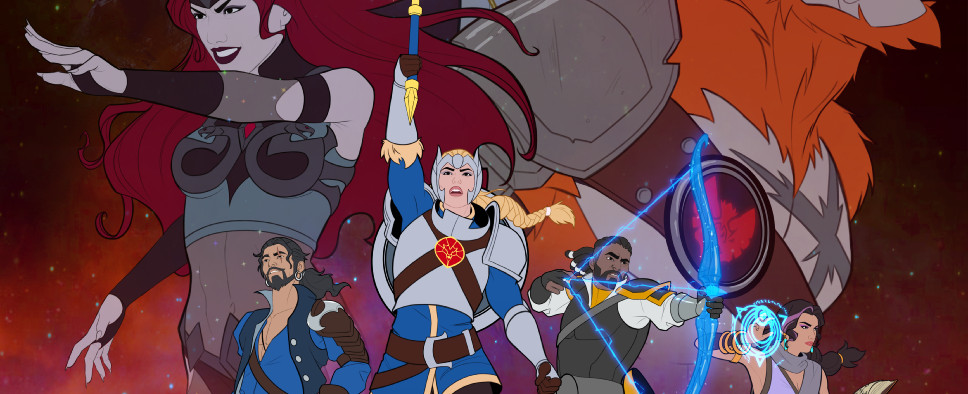MythForce Development Update - Shining a Light on Unreal 5
-
Category: News ArchiveHits: 4466

Last month's development update for Beamdog's roguelite adventure MythForce told us about the game's upcoming engine upgrade to Unreal Engine 5. And so now, Luke Rideout brings us another update that shines some light on this whole situation, so to speak, by focusing on certain lighting-related improvements the new engine will allow the team to utilize.
Apparently, not only will the new engine make the game look better, it will drastically reduce its file size and make it easier for the team to iterate on their work. Here are some additional details:
Greetings, friends. Project Director Luke here to share a little more about the state of MythForce.
We talked last time in broad strokes, but I want to go in-depth about major upcoming changes. Today I want to discuss our engine upgrade from Unreal Engine 4 to 5 and what that means for players.
We take player feedback seriously, and we want to address the issue of stability and performance, which has been sadly hit-or-miss, especially for players with computers closer to the lower end of our minimum specs. In the interest of making the game available to the broadest audience and making sure that experience is as consistent and smooth as possible, we realized that Unreal 5 offered a huge benefit in the long run.
Normally you wouldn’t make a major engine update mid-stream, because it’s a lengthy process and has the potential to create many new bugs and a fair amount of rework. Going into an engine upgrade like we have is, therefore, an important value judgment: What do we stand to gain while derailing our regular release schedule and delaying important updates?
Among many other important benefits, you should see a big increase in stability and performance as well as a big decrease in file size.
One of the major features of Unreal 5 is a brand-new lighting system, “Lumen,” which offers a much more efficient way of rendering lights in real-time. Most modern games, especially those that attempt to achieve a realistic look, use what’s called “PBR,” or “Physics-Based Rendering.” PBR makes it possible to achieve natural-looking light and shadow cast through techniques like ray tracing. This is great if you want your scenes to look realistic!
To achieve the look of MythForce’s environments, however, we use a ton of colorful lights to simulate the way a classic 2D cartoon background painting blends watercolor paints with a broad spectrum of colors to create a more vibrant scene than you would see in reality. We achieved this by placing light sources in the world that tint the color of our surfaces to great effect. Doing so required a lot of lights. We averaged 100–200 lights in some of our more complex rooms in Crypts of the Necromancer, for example.
Before Lumen, rendering all of those lights in real-time required a huge amount of processing power that just wouldn't work on your average computer. If we used dynamic lighting the way game studios have done in the past, we’d have to reduce the number of lights in a scene and balance that by increasing the ambient lighting in the world. But when we tried this, the result washed out the 2D watercolor painted look that we were trying to achieve, losing the vibrancy that defines the vibe of ’80s cartoon art.
To avoid this loss, we instead used something called “baked lighting,” which allowed us to have the lighting we wanted without needing all the light calculation in real-time. The drawback of baking our scenes that way is that those baked textures were massive. Every room in MythForce had four baked textures, one for each direction the room could face, which weighed in at anywhere from 70 to nearly 140 MB—and your computer would have to load those whole textures into memory for a few rooms at a time.
Lumen lets us get rid of those enormous textures. As a result, although the current retail build of the game—which contains only Bastion of the Beastlord—is 25 gigabytes, our internal build—which has both Bastion, Crypts of the Necromancer, and part of Cauldron of Bats—is only 10GB. That means our install size at 1.0 is going to be a quarter or less of the size we were trending toward.
The switch to this new lighting system requires the Art team to go back into all of our existing levels and re-light them using Lumen, which is time consuming. But it also means that future content we build will be more performant and ultimately save us time on content creation. That’s because it cuts out the step of baking our room textures, which used to require starting the bake at the end of the day and hoping it would be done by the morning—and which also needed to happen every time we made changes to level geography.
On top of all of that, there are benefits that help our team with faster development iteration time and engine features that reduce complexity in creating animations. It’s not always the immediately visible stuff that makes the biggest impact, but I hope you’ll agree the “juice is worth the squeeze,” even though it does mean that we’re working under the hood instead of on flashy, visible content. You’ll feel the results of this tune-up in how much smoother the game “drives” thanks to this transition to the updated UE5.
Next time, I’ll talk about some of the upcoming big changes to our metagame, so stay tuned!

